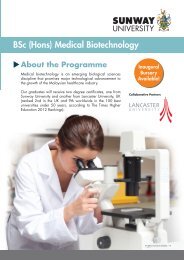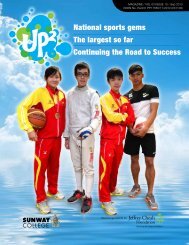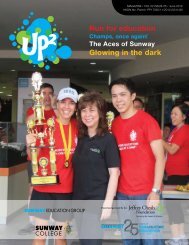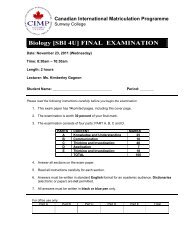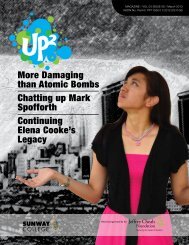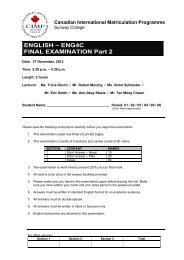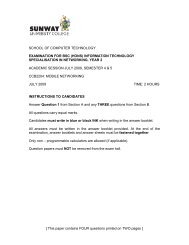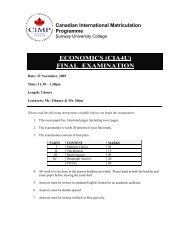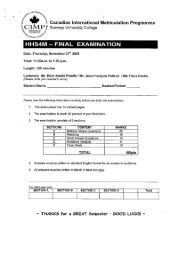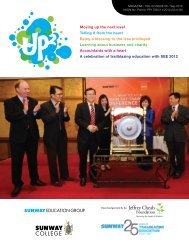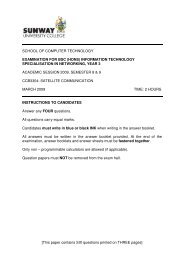Question Booklet
Question Booklet
Question Booklet
- No tags were found...
Create successful ePaper yourself
Turn your PDF publications into a flip-book with our unique Google optimized e-Paper software.
Canadian International Matriculation ProgrammeBusiness Leadership: Management Fundamentals(BOH4M)FINAL EXAMINATIONDate: May 30, 2012Time: 2:30 p.m. – 4:30 p.m.Length: 2 hoursLecturers: (Please circle your teacher’s name) Ms. Liz Erskine Mr. Dave LeonardStudent Name: _______________________________________ Section/Period: _______Please read the following instructions carefully before you begin the examination:1. This exam paper has nine (9) printed pages including this cover page.2. The examination is worth twenty percent (20%) of your final mark.3. The examination consists of three (3) sections, plus a communication component.SECTION CONTENT MARKS Student’sMarkAMultiple Choice <strong>Question</strong>s(Knowledge / Understanding)40BCShort Answer <strong>Question</strong>s(Thinking / Inquiry)Case Study Analysis(Application)1510D Overall Communication 10TOTAL 754. Answer Section A on the MULTIPLE CHOICE ANSWER sheet provided. Section B and C should beanswered in the answer booklet provided. Please hand in the MULTIPLE CHOICE ANSWER sheet,answer booklet and exam paper before leaving the classroom. Ensure that you write your name on theMULTIPLE CHOICE ANSWER sheet, the exam and answer booklet.5. Answers must be written in standard English format for an academic audience.6. Only paper dictionaries are allowed in the exam.7. All answers must be written in black or blue pen.Good Luck!Business Leadership: Management Fundamentals - May 2012 1
SECTION A: MULTIPLE CHOICE QUESTIONS(Knowledge / Understanding)40 marks(1 mark for each question)Instructions: Circle the correct answer: A, B, C, or D on the MULTIPLE CHOICE ANSWERSHEET provided.1. The process of deciding the most effective way to use an organization's resources for production of goodsand/or services is calledA. management.B. resource planning.C. strategic objective setting.D. planning.2. Providing guidance and encouragement to the employees to better their performance at work is anexample ofA. planning.B. controlling.C. organizing.D. leading.3. The process of finding the “one best way” to perform a task is called:A. scientific managementB. management scienceC. behavioural approachD. the human relations movement4. _____ describes the actions of employees who intentionally restrict output.A. SoldieringB. PartneringC. RestrictingD. Stopping5. Taylor saw the value of matching the job to theA. industry.B. pay scale.C. piece rate structure.D. worker.6. The Hawthorne studies identified that production ____ in relationship to ____ and psychologicalconditions rather than the ____.A. decreased; ethical; surroundingsB. increased; social; environmentC. evened out; personal; work pressureD. decreased; personal problems; wages7. Interpersonal communicationA. involves absorbing what another person is saying and responding to the person's concerns.B. involves sending and receiving verbal and nonverbal messages.C. is the science or study of the meanings of words and symbols.D. begins when the sense organs receive a stimulus.Business Leadership: Management Fundamentals - May 2012 2
8. The flow from the receiver to the sender is calledA. processing.B. perception.C. semantics.D. feedback.9. One of the most important principles for writing a good document isA. use of business terms.B. proofreading.C. passive voice in favor of active voice.D. use emotional phrases to add familiarity.10. A(n) _____ is a document that outlines the principles of conduct to be used in making decisions within anorganization.A. code of ethicsB. mission statementC. vision statementD. policy11. All of the individuals and groups that are directly or indirectly affected by an organization’sdecisions are its:A. stockholdersB. investorsC. employeesD. stakeholders12. Which among the following refers to ownership of ideas, such as inventions, books, movies, and computerprograms?A. Intellectual propertyB. OutsourcingC. Business sales contractD. Licensing13. What means the same as top-level, long-range planning?A. Technical planningB. Operations planningC. ControllingD. Strategic planning14. The SMART criteria offer helpful guidelines for stating and writing objectives. SMART stands forA. systematic, mission-focused, achievable, reliable, and target-oriented.B. specific, measurable, achievable, relevant, and time-based.C. systematic, maximized, assured, reliable, and target-oriented.D. sales-oriented, measurable, actionable, reliable, and time-based.15. Contingency plansA. tell a manager how to plan for routine situations.B. address the what-ifs of the manager’s job.C. are most needed in static environments.D. are also called strategic plans.Business Leadership: Management Fundamentals - May 2012 3
16. Corporate strategiesA. are sometimes called grand strategies.B. are established at the middle levels in the organization.C. involve a short-range to intermediate time horizon.D. include: differentiation, stability, focus, and combination strategies.17. SWOT is an acronym for an organization’sA. strengths, weaknesses, opportunities, and threats.B. strategy, willingness, objectives, and targets.C. synergy, weaknesses, objectives, and tactics.D. strategy, wisdom, operations, and tactics.18. _____ defines the boundaries of the formal organization.A. DecentralizationB. CentralizationC. The channelD. The organization structure19. _____ division of labor can result in utilizing each worker's best skills.A. IntegralB. HorizontalC. VerticalD. Irregular20. This refers to the number of different types of operations performed on the job.A. Job scopeB. Job depthC. Job rotationD. Job specification21. Which among the following principles states that authority in the organization flows through the chain ofmanagers one link at a time, ranging from the highest to the lowest ranks?A. ScalarB. Span of controlC. FlextimeD. Decentralization22. This involves grouping of jobs into related work units.A. OutsourcingB. DepartmentalizationC. SynergismD. Organizing23. ____ changes include such things as new equipment and new processes.A. strategicB. environmentalC. internalD. technological24. Which of the following is not likely to be an advantage of geographical departmentalization?A. It permits the use of local employees or salespeople.B. It can create customer goodwillC. It reduces costs drastically by having operations in multiple locations.D. It can lead to a high level of service.Business Leadership: Management Fundamentals - May 2012 4
25. ABC Inc. is a large sales organization that uses functional and then customer departmentalizationto create self-contained divisions. Each of its divisions is further divided by type of product and then bygeography. Identify the type of departmentalization being followed by ABC Inc.A. customerB. productC. hybridD. matrix26. This type of organizational structure has relatively few levels and relatively large spans of management ateach level.A. FlatB. VerticalC. TallD. Team27. Women executives forming an informal group to share ideas about issues that women in managementface is an example of a(n) _____ group.A. commandB. interestC. functionalD. project28. Group conformityA. is the degree of attraction among group members, or how tightly knit a group is.B. is the degree to which group members accept and follow group norms.C. is best defined as the informal rules a group adopts to regulate the behavior of group members.D. occurs when group members lose their ability to think as individuals and conform at theexpense of their good judgment.29. This is the dysfunctional syndrome that cohesive groups experience that causes the group to lose itscritical evaluative capabilities.A. GroupthinkB. AcceptanceC. Unity of commandD. Power30. Which of the following functions of management involves securing and developing people?A. StaffingB. ForecastingC. TrainingD. Job sharing31. A list of specific activities that must be performed to accomplish some job or task is a:A. job specificationB. job analysisC. job descriptionD. job evaluation32. Which among the following systems are characterized by less formal job descriptions and greateremphasis on adaptability?A. virtual systemsB. mechanistic systemsC. strategic systemsD. organic systemsBusiness Leadership: Management Fundamentals - May 2012 5
33. Matching the supply of people both internally and externally, to the openings available for a given frameof time, within an organization, falls under which category of the staffing process?A. ForecastingB. Personnel trainingC. Human resource planningD. Supply-demand maintenance34. _____ is concerned with what activates human behavior, what directs this behavior toward a particulargoal, and how this behavior is sustained.A. LeadershipB. EmpoweringC. NecessityD. Motivation35. The scientific management approach to motivation is based on the assumption that _____ is the primarymotivator of employees.A. moneyB. self-satisfactionC. recognitionD. power36. A(n) _____ need is satisfied by acceptance into meaningful groups of individuals.A. physicalB. esteemC. safetyD. social37. Which type of a leader is most likely to use an authoritarian style of leadership?A. Theory X leaderB. Theory Y leaderC. Participative leaderD. Laissez-faire leader38. _____ refers to characteristics the leader possesses.A. TraitB. StyleC. BehaviorD. Manner39. Conflict is a form ofA. communication.B. power.C. role.D. motivation.40. The _____ requires the manager to describe an employee's performance in written narrative form.A. interviewB. essay appraisalC. critical-incident appraisalD. graphic rating scaleBusiness Leadership: Management Fundamentals - May 2012 6
SECTION B: SHORT ANSWER QUESTIONS(Thinking / Inquiry / Communication)15 marks(5 marks each)Instruction:Choose and answer ONLY three (3) questions from the ones shown below. Your answersshould be in COMPLETE SENTENCES. All answers must be written in the answer bookletprovided. Note that a question worth 5 marks requires 5 solid points, and should besupported by examples, as required. Proofread carefully.1. Business strategy focuses on how an organization competes within an industry. Identify the threebusiness strategies and support your answer by referring to organizations that illustrate these strategies.2. Explain and discuss the five functions of management. Relate how these functions are performed in anorganization of your choice.3. Briefly describe the four (4) stages of team development as it relates to your ISU group or other team inwhich you have been involved in or are currently a member. Provide specific (NOT general) examples ofhow these stages applied to your team.4. List and briefly describe why managers need to communicate effectively and how to listen actively.5. Explain the levels of Maslow's Needs Hierarchy. Support your answer by referring to how a manager candirectly apply these needs relative to his/her employees.SECTION C: CASE STUDY ANALYSIS(Application / Communication)10 marksRESEARCH IN MOTIONResearch in Motion (RIM) is a multi-award-winning company that designs andproduces hardware, software, and service solutions for wireless communicationsused by worldwide business and consumer markets. These state-of-the-artproducts and services provide customers with immediate access to information inorder to make sound business decisions 24 hours a day, seven days a week.Whether you use the Blackberry device or the Pearl “smart” phone, you can be assured that you havepurchased a quality product connecting people either at work or at play, designed and built by one of themost innovative Canadian companies.BackgroundRIM is a Waterloo-based company founded in 1984 by two University of Waterloo engineering students, MikeLazaridis and Douglas Fregin. Today, Mike Lazaridis and Jim Balsillie, who joined the company in 1992, sharethe leadership role in the company as co-CEOs.The first Blackberry device came to market in 1999. Since then, RIM has consistently introduced many newand innovative products and services that are used by businesses and consumers around the world.Current ProductsThe Blackberry is aimed primarily at the business market. This hand-held unit functions with RIM solutions toprovide the user with access to time-sensitive information. Loyal users have flooded the market to the degreethat many people are blamed with never letting go of their “crackberry”. With minimal traditional marketing,this product has become a status symbol among business people.Business Leadership: Management Fundamentals - May 2012 7
The Blackberry unit allows the user both access to and the capability to work with a wide range of businessapplications, including such things as: work and personal email accounts calendar, address book, task lists, and spreadsheets internet and intranet access telephoneThe Blackberry Pearl, introduced by RIM years ago, moved away from the B2B market, and focused instead onthe consumer market and its demand for a product that allows access to various conveniences: wireless email, text messaging and digital video camera digital music playerThe RIM CultureRIM has a well-developed corporate culture that celebrates achievement, creativity, and risk taking. It has adevelop workforce that is motivated to achieve beyond its potential. The company supports this environmentthrough a variety of participative opportunities and programs.Employees at RIM are compensated by base pay, merit pay, and benefits. Benefits include a free Blackberry,on-site massage, subsidy for a fitness membership, and opportunities to participate in a variety of wellnessprograms. Social events include holiday parties, picnics, and team-building activities.Corporate LeadershipRIM is lead by an executive team comprised of co-CEOs. Balsillie also holds the position of chairman, whileLazaridis is also the company president. There are two chief operating officers; a chief financial officer; a vicepresident,Enterprise Business Unit; and vice-president, Corporate Marketing.Jim Balsillie is viewed as the public face of RIM, having a more charismatic and out-going personality thatpeople identify with. As well, he brings a wealth of business knowledge to the company, holding both adegree in commerce and an MBA. He is responsible for leading corporate strategy, business development,and the marketing, sales, and finance functions. Lazaridis, with his engineering degree, prefers to work in thebackground leading the technology innovation. He is passionate about science and electronics, and isresponsible for product strategy, research and development, product development, and manufacturing forthe company.Corporate PhilanthropyRIM is famous for its corporate giving. It strongly believes that it is important to give back to the community inwhich it operates. Communities support businesses and, in return, businesses must support communities. BothBalsillie and Lazaridis have been honored for their leadership and financial contributions that they haveindependently made to many regional-based organizations. Balsillie has donated money for a cancer-carecenter, as well as founded, and continues to fund, the a children’s museum. Lazaridis donated $100 million toestablish a world-class think tank and physics institute in Waterloo, Ontario, Canada. He also donated $50million to the University of Waterloo to help create a new computing center.What the Future HoldsThe wireless communications industry is an extremely competitive one, and RIM has positioned itself tocontinue to be a key player. The market for Blackberry products and service solutions continues to grow, andthe global opportunities remain extremely profitable.Information from www.rim.com, Business Leadership: Management Fundamentals - May 2012 8
Instruction and Advice:1. Answer the following questions using your own words. Any answer that has been copiedfrom the article, or insufficiently changed, will receive a grade of zero.2. DO NOT answer in point form; answer in complete sentences.3. For full marks, elaborate your answers and provide evidence when possible.4. Answer in the answer booklet provided. Identify each of the three questions appropriately.<strong>Question</strong>s (10 marks)1. Describe RIM’s commitment to corporate social responsibility. (2 marks)2. What strategy is RIM pursuing? (2 marks)3. How has the Blackberry changed the way business people communicate? Provide someadvantages and disadvantages of this way of communication to both the business and theemployee? (4 marks)4. Discuss the sources of personal power for each CEO. (2 marks)CRITERIACOMMUNICATIONCommunicates withclarity, supportive detailsand effectiveness.Able to organize and usecorrect English languageconventions (sentencestructure, spelling,grammar, punctuation)Level 12.5/5Communicateswith limitedclarity, supportandeffectiveness.Answers arepoorlyorganized andincomplete.Many languageconventionerrors.Language isunacceptable.Level 23/5Communicateswith someclarity, support,andeffectiveness.Answers aresomewhatorganized andcomplete. Afew Englishlanguageconventionswere found.Language isacceptable.Level 33.5/5Communicateswithconsiderableclarity, supportandeffectiveness.Answers arewell organizedand complete.Englishlanguageconventions areappropriate,with only one ortwo errors.Language isclear andappropriate.Level 44+ / 5Communicateswith a highdegree ofclarity, supportandeffectiveness.Answers areextremely wellorganized,complete andthorough.There are noerrors in Englishlanguageconventions,punctuation orother omissions.Business Leadership: Management Fundamentals - May 2012 9
BOH4M FINAL EXAMINATION (May 30, 2012)SECTION A: MULTIPLE CHOICE ANSWER SHEETSTUDENT NAME: ________________________________________________ Period ________________Lecturers: (Please circle your teacher’s name) Ms. Liz Erskine Mr. Dave LeonardINSTRUCTION: Circle only ONE letter (A, B, C, or D) based on the BEST ANSWER for each MCQ.1 A B C D2 A B C D3 A B C D4 A B C D5 A B C D6 A B C D7 A B C D8 A B C D9 A B C D10 A B C D11 A B C D12 A B C D13 A B C D14 A B C D15 A B C D16 A B C D17 A B C D18 A B C D19 A B C D20 A B C D21 A B C D22 A B C D23 A B C D24 A B C D25 A B C D26 A B C D27 A B C D28 A B C D29 A B C D30 A B C D31 A B C D32 A B C D33 A B C D34 A B C D35 A B C D36 A B C D37 A B C D38 A B C D39 A B C D40 A B C DBusiness Leadership: Management Fundamentals - May 2012 10
Business Leadership: Management Fundamentals - May 2012 11



